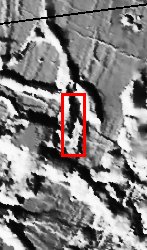Noctis Labyrinthus
Jet Propulsion Laboratory https://www.jpl.nasa.gov/ May 23, 2002

(Released 26 April 2002)
The Science
This image shows a portion of Noctis Labyrinthus, a large valley system at the western end of the Valles Marineris canyon system. Noctis Labyrinthus is notable for its unusual pattern of intersecting valleys, which give the region a maze-like appearance when viewed from above. The walls of these valleys are very high (~5 km) and quite steep, with slopes approaching 35°. Dust covers most of this region, leading to its rather uniform appearance. At the tops of the ridgelines, small dark streaks can be observed trailing downslope; these streaks suggest that the sediments covering this area occasionally become unstable and slide. Ridges of resistant material also can be observed in the highest terrains. In the lower half of the image, a small linear feature appears to cut across the generally NE/SW-trending slopes. This feature is not continuous, indicating that geologic activity has disrupted it since its formation. The northeastern termination of the feature is on a mesa, where it is joined by a less pronounced but similar feature that trends NE/SW. These small features may have originated in several ways: they may be ridges formed by compression, they may be small fault scarps, or they may represent the edges of ancient lava flows that have been disrupted by the formation of the valley system.
The Story
The smoothly sculpted surface in this close-up image belies the bizarre and twisted Martian landscape of which it is a part (seen at a larger scale in the context image). Labyrinths have long been in the human imagination, and it's no wonder that this area conjured up for early viewers all of the legends of antiquity, of a land where a Minotaur hides and a conquering hero needs a spool of thread to guide him through an inner maze.
As writer Jorge Luis Borges might say, this Martian region is a real-life example of a geological "garden of forking paths," a dangerous-seeming place where "the paths of the labyrinth converge." Noctis Labyrinthus, as it's called, is an area of sprawling, intersecting valleys on Mars, and like a Borgesian story, holds within it elusive truths about the passage of time and a multi-layered landscape of possibility.
At the western end of Valles Marineris, the largest canyon in the solar system, Noctis Labyrinthus holds the secrets to long-term geologic change in the area. It would be easy to lose oneself on a wandering path through the terrain. The walls of this Martian valley maze rise swiftly and steeply to their three-mile heights, and a layer of long-settled dust deceives the eye, making everything look the same. (Well, almost everything. Look closely, and some of realities of the labyrinth are revealed.)
From the tops of ridge lines, small, dark streaks trail down the sides, leaving scant but clear evidence of the sediment that once slid downslope. A long, jagged slash cuts the land (lower third of the image), but is broken in the middle by some unknown geologic force that moved the land through it, "erasing it" sometime later. And then the mysteries: what are the features seen in this image and how did they come to be? Ridges formed by compression? Small cliff lines ("scarps") caused by faults? Or perhaps the edges of ancient lava flows, disrupted by the formation of the valley system?
Whatever they are, they represent well the strange and misleading passageways of legend and lore, where the way to the truth of the matter and back again is hard to find.
